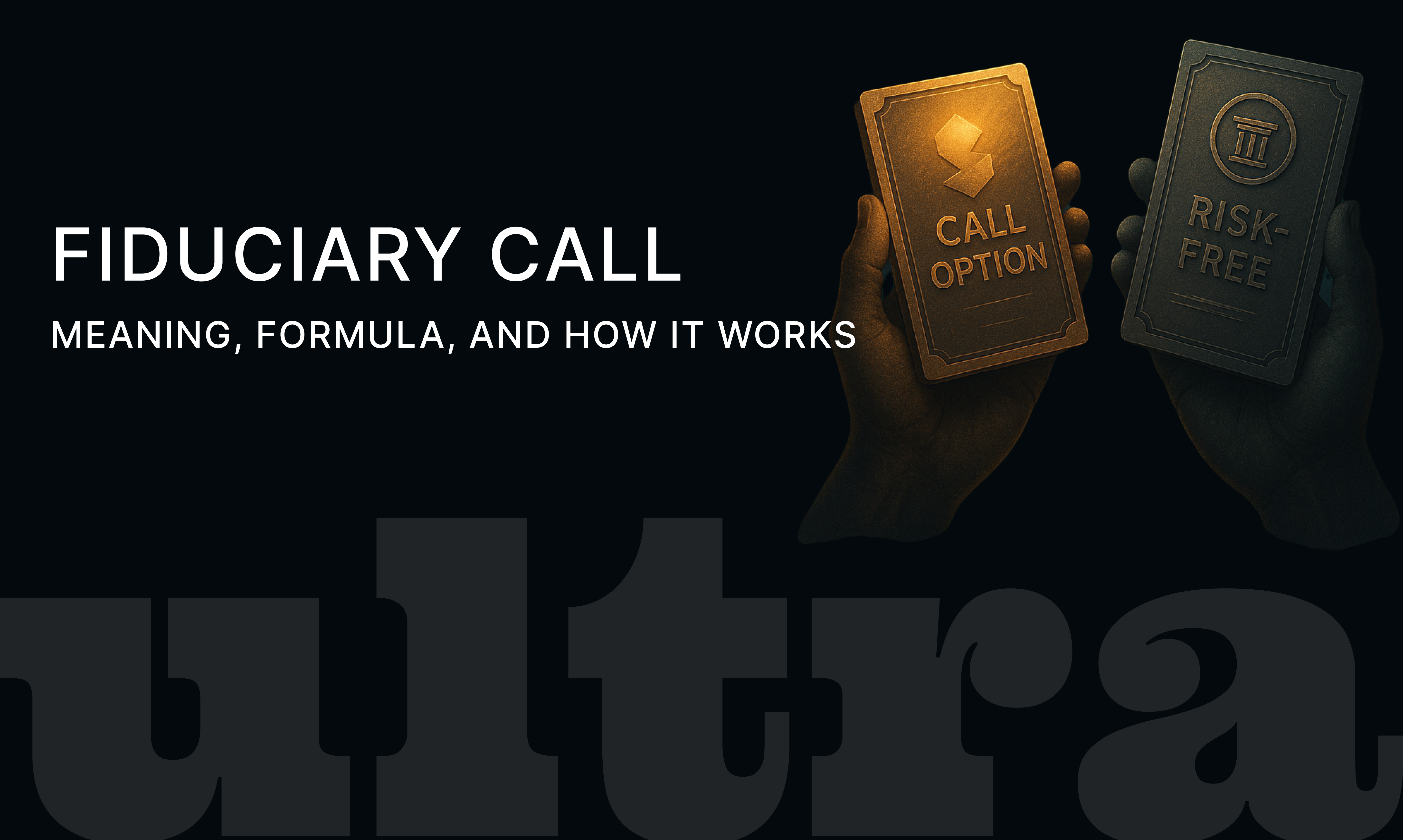What Is a Fiduciary Call?
22 July 2025 · Sachin Gadekar
What Is a Fiduciary Call and How Does It Work?

What Is a Fiduciary Call?
Fiduciary Call is an important concept for anyone interested in derivatives, options strategies, and investment risk management. Popular among advanced traders and CFA candidates, this strategy combines a call option with a risk-free bond or deposit to replicate the payoff of a protective put.
In this guide by Ultra, we’ll break down what a fiduciary call means, how it works, its formula, payoff, and why it matters for investors.
A fiduciary call is a strategy in options trading where an investor buys a call option and simultaneously invests in a risk-free bond (or deposit). The purpose is to ensure that even if the call expires worthless, the investor still receives the principal amount through the bond.
It’s an example of put-call parity, which states that holding a call option plus a risk-free bond replicates the payoff of holding a put option plus the underlying stock.
In simple terms: A fiduciary call helps manage downside risk while allowing the investor to benefit if the underlying asset’s price rises.
Fiduciary Call Meaning and Context
The word “fiduciary” means holding something in trust for someone else. In this strategy, the risk-free bond acts as a fiduciary element, guaranteeing a return of the principal if the option is not exercised.
It is also known as the “protective call” or “synthetic protective put.”
Where Is Fiduciary Call Used?
Options trading: To hedge risk.
Portfolio management: To replicate payoffs of protective puts.
CFA curriculum: As an example of put-call parity.
Institutional investors: As a low-risk hedging approach.
How Does a Fiduciary Call Work?
The investor does two things:
1. Buys a European call option for the underlying stock.
2. Invests in a zero-coupon bond or deposit that will mature to the strike price.
At maturity:
If the stock price is above the strike price, the call option is exercised, providing profits.
If the stock price is below the strike price, the call option expires worthless, but the bond matures at full value, covering the strike price amount.
Fiduciary Call Formula
The relationship is derived from put-call parity:
Call Option + PV(X) = Put Option + Stock
Where:
PV(X) = Present Value of the strike price (risk-free bond).
The fiduciary call structure is: Call Option + Risk-Free Deposit.
Fiduciary Call Payoff
The payoff at expiry is straightforward:
Fiduciary Call Payoff = max(S – X, 0) + X
Where:
S = Stock price at expiry
X = Strike price
The payoff is similar to holding a put option plus the underlying stock.
Example of a Fiduciary Call
Suppose an investor wants to replicate a protective put using a fiduciary call.
Stock price today: Rs 500
Strike price of call: Rs 500
Risk-free rate: 5% annual
Time: 1 year
Investor actions:
Buy a call option with a strike price of Rs 500.
Invest the present value of Rs 500 in a risk-free bond (about Rs 476 if the risk-free rate is 5%).
Outcomes at expiry:
If the stock price rises to Rs 600 Call option exercised → Profit Rs 100 + Bond matures to Rs 500 → Total Rs 600.
If the stock price drops to Rs 400:
Call option expires worthless → Bond matures to Rs 500 → Loss avoided due to bond.
Advantages & Disadvantages
Advantages of a Fiduciary Call
Lowers downside risk compared to buying just a call option.
Provides flexibility for hedging.
Can replicate other option payoffs.
Helps understand arbitrage opportunities in options pricing.
Disadvantages
Limited to European options (valid at expiry only).
May involve higher transaction costs.
Requires knowledge of interest rates for calculating bond prices.
Related Strategies
Protective Put: Buy the stock + buy a put option.
Covered Call: Hold the stock + sell a call option.
Synthetic Positions: Combining derivatives to replicate other payoffs.
FAQs
Q1. What is a fiduciary call in simple terms?
A fiduciary call is a strategy where an investor buys a call option and simultaneously invests in a risk-free bond to replicate the payoff of a protective put.
Q2. What is the formula for a fiduciary call?
Fiduciary Call = Call Option + Present Value of Strike Price. The payoff equals max(S – X, 0) + X.
Q3. Why is fiduciary call important in CFA?
It helps CFA students understand put-call parity, option pricing, and arbitrage opportunities.
Q4. What is fiduciary call payoff?
It equals the maximum of (Stock Price – Strike Price, 0) plus the value of the risk-free bond at maturity.
Q5. How is fiduciary call different from protective put?
A protective put buys a stock and a put option. A fiduciary call buys a call option and invests in a risk-free bond to achieve a similar payoff.
Final Thoughts
A fiduciary call is a smart example of how financial instruments can be combined for better risk management. Whether you are preparing for CFA, managing a portfolio, or exploring advanced derivatives strategies, understanding the fiduciary call will help you navigate the world of options with confidence.
To read more about strategies like fiduciary calls, explore Ultra’s blog for insights on investments, fixed deposits, and smarter wealth planning.